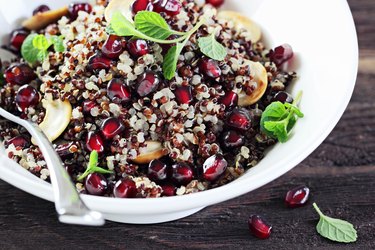
Losing 1 stone, or 14 pounds, in one month is an ambitious goal that's only possible if you have a lot of weight to lose and commit to a strict eating and exercise routine. Even if you can't quite lose a full stone, you can use a month to jump-start your weight loss, look better, feel stronger and improve your health markers, such as blood pressure and heart disease risk.
Set a Reasonable Goal
Video of the Day
The more weight you have to lose, the easier it is to lose a lot in the first month. If you eat a lot of processed foods and are quite sedentary, drastic changes to your diet and exercise plan may cause you to lose weight rather dramatically during the first two weeks, as you drop water weight. This means you could potentially lose a stone in a month. If, however, you already eat healthfully, exercise regularly and are just 1 stone away from your ideal weight, you won't be able to reach that goal safely or sustainably.
Video of the Day
For people with obesity who are in acute danger of weight-related diseases, a very low calorie diet, or VLCD, may be administered by a health care professional. A VLCD involves eating fewer than 800 calories each day, usually in the form of medically formulated liquid shakes, soups and bars.
A VLCD can result in 3 to 5 pounds of fat loss per week, which would get you to your goal. However, there are side effects and a risk of gallstones, which can be painful. You should not attempt a VLCD unless your doctor recommends it.
You may, however, follow a low-calorie diet and lose up to 3 pounds per week in the first couple of weeks, and 1 to 2 pounds in the following weeks. This is a manageable, sustainable and healthy rate of loss recommended by most health organizations, including the Centers for Disease Control and Prevention.
Reduce Your Calorie Intake Sensibly
Reducing your calorie intake by about 500 to 1,000 calories per day is a reasonable strategy that should leave you feeling good and with enough energy to exercise and be active. Your doctor or a nutritionist can crunch the numbers to give you a better idea of how many calories you should be consuming based on your age, size, gender and activity level.
Reducing your calories more than this, without medical supervision, can result in lethargy, illness and nutritional deficiencies, which will not help you reach your health goals.
Read more: 7-Day Weight Loss Eating Plan
Focus Your Diet on Quality Foods
Healthy, whole foods like fresh produce, lean meats, low-fat dairy and whole grains support weight loss. Choose foods that have lots of nutritional value and few calories per serving. For example, leafy greens -- including spinach and kale -- peppers, berries and tomatoes help fill you up, without filling you out.
Lean proteins provide you with this important nutrient that helps you maintain lean muscle as you drop pounds. Go for options such as tuna canned in water, flank steak, chicken breast, eggs and tofu. Whole grains are slightly denser in calories, so stick to 1/2- to 1-cup servings of grains such as brown rice, quinoa and barley.
Examples of quality meals that assist with weight loss are oatmeal with skim milk and berries; poached egg on a whole-grain English muffin with an orange; a large green salad topped with raw vegetables, grilled chicken, olive oil and red wine vinegar alongside a whole-wheat roll; corn tortillas wrapped around black beans, red onions and salsa; a 90-percent lean ground beef patty with a sweet potato and steamed spinach; or a turkey breast cutlet with mushrooms and sauteed kale.
Get Active
Eating high-quality foods and modest portions are big steps toward your weight-loss goal. Moving more is also essential. If you don't engage in cardio exercise to burn calories and strength training to maintain muscle, a quarter of every pound you lose will be lean muscle mass. That's 3.5 pounds of lost muscle if you lose a stone through diet alone. Muscle burns more calories at rest than does fat tissue, so this loss of muscle makes it harder to lose weight. Having toned muscles from working out also helps you look healthy and fit.
Cardio exercise involves moving the largest muscles of the body, raises the heart rate and helps you break a sweat -- think brisk walking, jogging, swimming and cycling. Aim for at least 250 minutes per week for noticeable fat loss. Perform strength training at least two times per week on nonconsecutive days. Target every major muscle group with one to four sets of eight to 12 repetitions that use resistance heavy enough to fatigue the muscles by the last couple of reps.
Keep in mind that muscle is denser than fat, but it weighs the same pound for pound. If you put on muscle and lose fat, you may not see the scale move much and you may not lose a stone. But you will look simmer, be stronger and feel better.
Read more: Tips on Losing Weight Fast
- National Institute of Diabetes and Digestive and Kidney Diseases: Very Low-Calorie Diets
- National Institute of Diabetes and Digestive and Kidney Diseases: Weight Loss and Nutrition Myths
- Centers for Disease Control and Prevention: Losing Weight
- USDA Dietary Guidelines for Americans 2015: Estimated Calorie Needs per Day, by Age, Sex, and Physical Activity Level